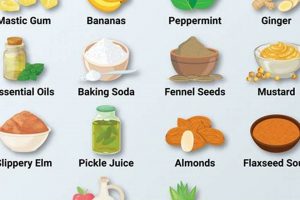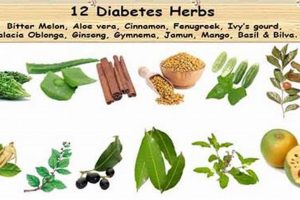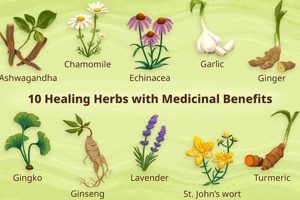Substances derived from plants, prepared and utilized to potentially address diminished sexual desire in women, fall under the broad category of natural therapies intended to improve overall well-being. These preparations can include tinctures, capsules, teas, or topical applications formulated with various botanical ingredients.
Throughout history and across cultures, plants have been integral to traditional medicine systems, often considered sources of vitality and hormonal balance. Their application in this context stems from the belief that certain phytocompounds may influence physiological processes associated with sexual function, emotional state, and overall energy levels. Such approaches represent a holistic perspective on female sexual health.
The subsequent discussion will delve into specific botanicals commonly cited in relation to female sexual function, examining available scientific evidence, potential mechanisms of action, and important considerations regarding safety and efficacy.
Considerations for Botanical Approaches to Female Sexual Desire
The following points offer guidance when exploring plant-based options to potentially support female sexual well-being. Due diligence and informed choices are paramount.
Tip 1: Consult with a Qualified Healthcare Professional: Prior to initiating any herbal regimen, seeking advice from a physician, gynecologist, or licensed herbalist is essential. They can assess individual health status, identify potential contraindications with existing medications, and provide personalized recommendations.
Tip 2: Research Specific Botanicals Thoroughly: Evidence regarding the efficacy of various plants differs significantly. Investigate available scientific studies, traditional uses, and potential side effects before selecting any particular herb. Reputable sources, such as peer-reviewed journals and databases, should be prioritized.
Tip 3: Source Products from Reputable Manufacturers: The quality and purity of herbal preparations can vary substantially. Choose products from established companies that adhere to good manufacturing practices (GMP) and provide transparent information about sourcing, extraction methods, and quality control procedures.
Tip 4: Start with Low Doses and Monitor Effects: When introducing a new botanical, begin with a low dose and gradually increase it while carefully observing for any adverse reactions. Keeping a detailed record of dosage, timing, and effects can help determine optimal individual tolerance.
Tip 5: Be Patient and Realistic About Expectations: Herbal interventions often require consistent use over a period of weeks or months to achieve noticeable effects. Avoid expecting immediate or dramatic results, and maintain a realistic outlook regarding the potential benefits.
Tip 6: Recognize Potential Interactions: Certain plants can interact with prescription medications, over-the-counter drugs, and other supplements. Thoroughly research potential interactions and inform the healthcare provider about all substances being consumed.
Tip 7: Prioritize Holistic Well-being: Addressing potential underlying factors, such as stress, relationship dynamics, or hormonal imbalances, is crucial for achieving sustained improvements in sexual desire. Incorporating stress management techniques, engaging in regular physical activity, and maintaining open communication with a partner can complement the use of botanicals.
Implementing these strategies promotes a more informed and cautious approach to incorporating plant-derived substances in the pursuit of improved female sexual health.
The subsequent sections will explore the scientific evidence and practical considerations surrounding the use of specific botanicals.
1. Botanical Identification
The correct identification of plant species used in preparations intended to enhance female sexual desire is of paramount importance. Misidentification can lead to the ingestion of substances with no therapeutic benefit or, more seriously, to adverse health consequences due to the presence of toxic compounds in incorrectly identified plants. The intended physiological effects of a particular botanical ingredient are predicated on its inherent chemical composition. If the source plant is incorrectly identified, the expected effects are unlikely to materialize, and unintended, potentially harmful effects may occur. For example, confusing Withania somnifera (Ashwagandha), a frequently cited adaptogen, with a related but chemically distinct species could negate any anticipated benefits and possibly introduce unwanted compounds into the body.
The practical significance of accurate botanical identification extends to ensuring product safety and efficacy. Reputable manufacturers of herbal remedies employ stringent quality control measures, including macroscopic and microscopic examination of plant materials, as well as chemical analysis (e.g., high-performance liquid chromatography or HPLC) to verify the authenticity and purity of their ingredients. Independent third-party testing provides an additional layer of assurance. Consumers should seek products from manufacturers who provide detailed information about their sourcing and quality control processes, including scientific names and authentication methods used to verify the identity of the plant species. Claims of “proprietary blends” without proper species identification should be viewed with skepticism.
In summary, accurate botanical identification is a fundamental prerequisite for the safe and effective use of herbal remedies aimed at enhancing female sexual desire. Implementing rigorous quality control measures throughout the supply chain, from sourcing to manufacturing, and encouraging transparency regarding species identification are crucial steps in safeguarding consumer health and promoting responsible use of plant-based substances. Lack of attention to botanical identification undermines the potential benefits and introduces unacceptable risks.
2. Preparation Methods
The method by which plant materials are processed into usable forms significantly impacts the bioavailability, potency, and overall effectiveness of herbal remedies intended to address female sexual desire. Variations in extraction techniques, solvents used, and final formulations can substantially alter the concentrations of active compounds and their subsequent absorption and utilization by the body.
- Aqueous Extracts (Teas and Infusions)
Aqueous extraction, involving the use of water as a solvent, is a common method for preparing herbal teas and infusions. This method is suitable for extracting water-soluble compounds from plant materials. However, it may not effectively extract lipophilic (fat-soluble) compounds, potentially limiting the overall therapeutic profile. The concentration of active constituents in aqueous extracts is often lower compared to other extraction methods.
- Alcoholic Extracts (Tinctures)
Alcohol, typically ethanol, is a more potent solvent than water, capable of extracting a broader range of compounds, including both water-soluble and lipophilic substances. Tinctures, which are alcoholic extracts, generally exhibit higher concentrations of active constituents compared to aqueous extracts. The alcohol concentration influences the extraction efficiency; higher concentrations are often used for resins and oils. However, alcohol consumption may be a concern for some individuals.
- Capsules and Tablets (Powdered Herbs)
Encapsulation of powdered herbs offers a convenient method for consumption. However, the bioavailability of active compounds from powdered herbs can vary depending on particle size, disintegration rate, and the presence of excipients (inactive ingredients) in the formulation. Standardization of powdered herbs ensures consistent concentrations of active constituents.
- Lipid Extracts (Oils and Creams)
Lipid extracts, utilizing oils as solvents, are particularly effective for extracting lipophilic compounds from plant materials. These extracts are often used in topical applications, such as creams and oils, intended for local absorption. The choice of oil (e.g., olive oil, coconut oil) can influence the extraction efficiency and the stability of the final product.
The selection of an appropriate preparation method should align with the specific plant material being used, the desired therapeutic compounds, and the intended route of administration. The quality control processes employed by manufacturers, including standardization and testing for contaminants, are crucial for ensuring the safety and efficacy of herbal remedies designed to support female sexual well-being. Understanding the nuances of these preparation methods is essential for both practitioners and individuals seeking plant-based solutions.
3. Dosage Regimen
The dosage regimen is a critical determinant of the efficacy and safety of plant-derived substances employed to address diminished sexual desire in women. It dictates the quantity of the botanical substance administered, the frequency of administration, and the duration of treatment. An inadequate dosage may fail to elicit the desired physiological response, while an excessive dosage can increase the risk of adverse effects. The appropriate dosage must consider individual factors such as body weight, metabolic rate, and pre-existing health conditions. For example, a woman with a lower body weight or impaired liver function may require a lower dosage compared to a larger individual with normal hepatic function. The inherent variability in the concentration of active compounds within herbal preparations further necessitates careful dosage adjustments. Products standardized to a specific concentration of the active constituent allow for more precise dosing.
The establishment of an effective dosage regimen often involves a gradual titration approach, starting with a low dose and incrementally increasing it until the desired effect is achieved, or adverse effects are observed. This process necessitates careful monitoring of both subjective and objective parameters. Subjective parameters include self-reported changes in libido, sexual arousal, and overall well-being. Objective parameters may involve hormonal assays or other relevant biomarkers. Failure to adhere to a carefully designed and monitored dosage regimen can compromise the therapeutic benefits of the herbal remedy and potentially lead to undesirable outcomes. For instance, the use of Tribulus terrestris without appropriate dosage control may result in negligible improvement in libido and could potentially affect hormonal balance.
In conclusion, the dosage regimen is an indispensable component of any strategy involving herbal interventions for female sexual desire. It requires meticulous attention to individual factors, careful product selection, and diligent monitoring. The challenges associated with accurately determining the optimal dosage underscore the importance of consulting with qualified healthcare professionals experienced in the use of herbal medicines. A personalized and evidence-informed approach to dosage regimen is essential for maximizing the potential benefits and minimizing the risks associated with these interventions.
4. Potential Interactions
The use of plant-derived substances to potentially augment female sexual desire necessitates thorough consideration of potential interactions with pharmaceuticals, other herbal supplements, and even dietary factors. The complex chemical composition of botanical remedies introduces the possibility of synergistic, additive, or antagonistic effects when combined with other substances, potentially altering their intended therapeutic actions or increasing the risk of adverse reactions.
- Drug-Herb Interactions
Many pharmaceuticals are metabolized by cytochrome P450 enzymes in the liver. Certain herbal remedies can either induce or inhibit these enzymes, thereby affecting the concentration of the drug in the bloodstream. For instance, St. John’s Wort, sometimes used to address mood, can significantly reduce the effectiveness of oral contraceptives due to enzyme induction. Conversely, other herbs might inhibit these enzymes, leading to elevated drug levels and an increased risk of toxicity. Awareness of these potential interactions is crucial to prevent unintended consequences.
- Herb-Herb Interactions
The concurrent use of multiple herbal remedies carries the risk of additive or synergistic effects. While some combinations may offer enhanced therapeutic benefits, others can lead to unpredictable or adverse outcomes. For example, combining two herbs with sedative properties, such as valerian and chamomile, may result in excessive drowsiness or impaired cognitive function. A thorough assessment of the pharmacological properties of each herb is essential to avoid undesirable interactions.
- Herb-Food Interactions
Dietary factors can also influence the absorption, metabolism, and excretion of herbal constituents. For example, grapefruit juice is known to inhibit certain cytochrome P450 enzymes, potentially altering the metabolism of certain herbs and increasing their bioavailability. High-fiber diets may reduce the absorption of some herbal compounds, decreasing their effectiveness. Therefore, it is prudent to consider dietary habits when prescribing or recommending herbal remedies.
- Interactions with Existing Health Conditions
Pre-existing health conditions can also affect how a person responds to herbal remedies. Individuals with autoimmune disorders, for instance, should exercise caution when using herbs that stimulate the immune system, as this could exacerbate their condition. Similarly, those with bleeding disorders should avoid herbs that have anticoagulant properties, such as ginger and ginkgo, due to the increased risk of bleeding.
In summary, a comprehensive understanding of potential interactions is crucial when considering botanical interventions to address female sexual desire. Evaluating potential drug-herb, herb-herb, and herb-food interactions, as well as the impact of pre-existing health conditions, is paramount to ensuring safe and effective use. Consultation with qualified healthcare professionals is essential for identifying and mitigating potential risks.
5. Efficacy Evidence
The relationship between demonstrable proof of effectiveness and the utilization of plant-derived substances intended to address diminished sexual desire in women is critical. The absence of robust scientific support for a particular botanical’s purported benefits undermines its clinical utility and raises ethical concerns regarding its recommendation or use. In situations where evidence of efficacy is lacking, the observed improvements reported by individuals may be attributable to placebo effects, spontaneous remission, or other confounding variables. The lack of credible scientific evidence introduces uncertainty regarding the potential magnitude of effect, the optimal dosage, and the long-term safety profile. The use of plant-based interventions without demonstrable efficacy evidence represents a deviation from evidence-based practice, potentially leading to ineffective treatments and the neglect of more effective therapeutic options.
The process of establishing efficacy evidence for these substances requires rigorous scientific methodology, including randomized controlled trials (RCTs), systematic reviews, and meta-analyses. RCTs, in which participants are randomly assigned to receive either the botanical intervention or a placebo, represent the gold standard for evaluating efficacy. Systematic reviews and meta-analyses, which synthesize the findings of multiple RCTs, provide a more comprehensive assessment of the overall evidence base. The presence of well-designed RCTs demonstrating a statistically significant and clinically meaningful improvement in sexual function outcomes, compared to placebo, is essential for substantiating claims of efficacy. However, the methodological quality of existing studies on these substances varies significantly. Many studies suffer from limitations such as small sample sizes, inadequate blinding, and a lack of standardized outcome measures, thereby limiting the strength of the conclusions that can be drawn.
In conclusion, efficacy evidence is the cornerstone of responsible and ethical use of plant-derived substances for diminished sexual desire in women. The pursuit of rigorous scientific evidence, through well-designed RCTs and systematic reviews, is essential for informing clinical decision-making and ensuring that individuals receive treatments that are both effective and safe. The absence of such evidence should prompt a cautious approach and necessitate a thorough discussion of the potential risks and benefits with a qualified healthcare professional, while also exploring alternative, evidence-based options. A commitment to evidence-based practice is paramount to protecting the well-being of individuals seeking solutions for sexual dysfunction.
6. Safety Profile
The safety profile of plant-derived substances intended to address diminished sexual desire in women is inextricably linked to their potential benefits and risks. A thorough understanding of a botanical’s safety profile necessitates a comprehensive assessment of potential adverse effects, contraindications, and interactions with other substances. Failure to adequately evaluate safety can result in unintended harm, ranging from mild discomfort to serious health complications. For instance, certain plants known to possess estrogenic properties may be contraindicated in women with a history of hormone-sensitive cancers. Similarly, some botanicals may exhibit anticoagulant effects, posing a risk to individuals taking blood-thinning medications. The presence of pyrrolizidine alkaloids in some plant species can lead to liver toxicity, highlighting the importance of rigorous quality control and accurate identification. A substance’s safety profile, therefore, directly impacts its suitability as a therapeutic option.
A comprehensive safety assessment should encompass both pre-clinical and clinical data. Pre-clinical studies, including in vitro and in vivo experiments, provide initial insights into potential toxicities and mechanisms of action. Clinical trials, conducted in human subjects, are essential for evaluating the safety and tolerability of the substance at various dosages and durations of use. The results of these studies should be carefully scrutinized to identify any statistically significant adverse effects or trends. Furthermore, post-market surveillance, involving the monitoring of adverse events reported by consumers, can provide valuable information about the long-term safety of the botanical. These findings should inform the development of appropriate warnings and precautions for use. The lack of robust safety data for many plant-derived substances highlights the need for caution and underscores the importance of seeking guidance from qualified healthcare professionals.
In conclusion, the safety profile is an indispensable component of any consideration involving plant-derived substances for female sexual desire. Comprehensive safety evaluations, encompassing pre-clinical studies, clinical trials, and post-market surveillance, are essential for identifying potential risks and informing responsible usage. The complexity of botanical composition and the potential for interactions necessitate careful assessment and individualized recommendations. Prioritizing safety and seeking guidance from knowledgeable healthcare providers can help ensure that plant-based interventions are used responsibly and effectively to support female sexual well-being. The absence of rigorous safety data warrants a cautious approach and should prompt a thorough discussion of the potential risks and benefits.
Frequently Asked Questions Regarding Botanical Approaches to Female Sexual Desire
The following section addresses common inquiries and clarifies prevalent misconceptions concerning the use of plant-derived substances intended to address diminished sexual desire in women. The information provided is intended for educational purposes and should not be construed as medical advice.
Question 1: Are all herbal remedies for diminished sexual desire in women safe?
No, not all such remedies are inherently safe. The safety profile of a given botanical depends on factors such as the specific plant species, its preparation method, dosage, potential interactions with other medications, and the individual’s pre-existing health conditions. Consulting a qualified healthcare professional is crucial before initiating any herbal regimen.
Question 2: Is there scientific evidence supporting the efficacy of herbal remedies for this purpose?
The level of scientific evidence varies significantly among different botanicals. Some substances have undergone preliminary research suggesting potential benefits, while others lack robust clinical data. Rigorous randomized controlled trials (RCTs) are necessary to definitively establish efficacy. Individuals should critically evaluate the available evidence before using any herbal remedy.
Question 3: Can herbal remedies interact with prescription medications?
Yes, interactions between herbal remedies and prescription medications are possible. Certain botanicals can affect the metabolism or absorption of drugs, potentially altering their efficacy or increasing the risk of adverse effects. Informing a healthcare provider about all medications and supplements being taken is essential to avoid harmful interactions.
Question 4: Are standardized herbal extracts superior to non-standardized preparations?
Standardized extracts, which contain a consistent concentration of specific active compounds, offer greater assurance of potency and predictability compared to non-standardized preparations. Standardization reduces variability in the product, facilitating more precise dosing and potentially enhancing therapeutic outcomes. However, standardization alone does not guarantee efficacy or safety.
Question 5: How long does it typically take to experience the effects of herbal remedies for this purpose?
The time required to experience noticeable effects varies depending on the individual, the specific botanical being used, the dosage, and the underlying cause of the diminished sexual desire. Some individuals may experience improvements within a few weeks, while others may require several months of consistent use. Patience and realistic expectations are essential.
Question 6: What are the potential side effects of herbal remedies marketed for diminished sexual desire in women?
Potential side effects vary depending on the specific botanical. Common side effects may include gastrointestinal upset, headaches, skin rashes, or changes in menstrual cycles. More serious adverse effects, such as liver toxicity or hormonal imbalances, are possible with certain botanicals. Discontinuing use and seeking medical attention is crucial if any concerning symptoms develop.
The information provided herein underscores the importance of informed decision-making, responsible usage, and consultation with qualified healthcare professionals when considering botanical approaches to address diminished sexual desire in women.
The subsequent sections will discuss the regulatory landscape surrounding these substances.
Conclusion
This exploration of herbal remedies for libido female has illuminated the complexities inherent in their application. The variable efficacy, potential interactions, and the critical importance of accurate identification and dosage control necessitate a cautious and informed approach. Scientific rigor, ethical considerations, and individualized assessments remain paramount when considering these substances.
The responsible utilization of botanical interventions in addressing female sexual desire hinges on continued research, stringent quality control, and open communication between individuals and qualified healthcare providers. The pursuit of well-being must be guided by evidence and informed consent, ensuring that potential benefits are weighed carefully against potential risks.







